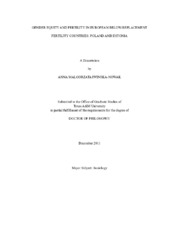| dc.contributor.advisor | Poston, Dudley L. | |
| dc.creator | Iwinska-Nowak, Anna Malgorzata | |
| dc.date.accessioned | 2012-02-14T22:19:59Z | |
| dc.date.accessioned | 2012-02-16T16:16:18Z | |
| dc.date.available | 2014-01-15T07:05:33Z | |
| dc.date.created | 2011-12 | |
| dc.date.issued | 2012-02-14 | |
| dc.date.submitted | December 2011 | |
| dc.identifier.uri | https://hdl.handle.net/1969.1/ETD-TAMU-2011-12-10427 | |
| dc.description.abstract | Much of the recent scholarly attention has been devoted to the low fertility situation experienced by a growing number of developed countries. In this context, the theoretical framework explicitly incorporating the issues of gender in explanations of low fertility has been gaining notable popularity.
This dissertation is focused primarily on the application of McDonald's theory of gender equity to the fertility context of two post-communist "low" and "very low" fertility countries, namely Poland and Estonia. Additionally, it tests the relative importance of gender equity at the societal level and the level of the family, contrasts the results of using different operationalizations of gender equity in the family, and compares the effects of gender equity on male and female fertility.
I estimate two sex-specific models for Poland and two-sex specific models for Estonia, which respectively use three and two independent variables capturing gender equity in different institutions as well as in the family. All the models use intended fertility as the dependent variable operationalized as either the intention to have the second or higher order birth or the number of additional children intended.
The main findings of this dissertation support the gendered explanation of low fertility in Poland and Estonia. More specifically, they indicate that gender equity in the family significantly increases fertility intentions of Polish men and women and Estonian women but not men. However, in none of the models there is evidence that gender equity in institutions outside the family matters to fertility. All in all, the findings support the gendered approach to fertility.
The results of my dissertation indicate that it is important to pay attention to how we measure gender equity. I observe some variation in the findings depending on how stringent definition of equity is used. Finally, my research suggests that the importance of gender equity for women's fertility might be more universal but it is also not completely irrelevant to the fertility of men.
I conclude this dissertation with a discussion of the implications of my findings and the potential for future development of research in this area. | en |
| dc.format.mimetype | application/pdf | |
| dc.language.iso | en_US | |
| dc.subject | fertility | en |
| dc.subject | gender equity | en |
| dc.subject | Poland | en |
| dc.subject | Estonia | en |
| dc.title | Gender Equity and Fertility in European Below-Replacement Fertility Countries: Poland and Estonia | en |
| dc.type | Thesis | en |
| thesis.degree.department | Sociology | en |
| thesis.degree.discipline | Sociology | en |
| thesis.degree.grantor | Texas A&M University | en |
| thesis.degree.name | Doctor of Philosophy | en |
| thesis.degree.level | Doctoral | en |
| dc.contributor.committeeMember | McIntosh, William A. | |
| dc.contributor.committeeMember | Saenz, Rogelio | |
| dc.contributor.committeeMember | Wunneburger, Douglas F. | |
| dc.type.genre | thesis | en |
| dc.type.material | text | en |
| local.embargo.terms | 2014-01-15 | |


